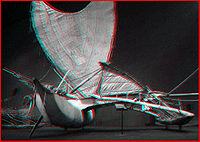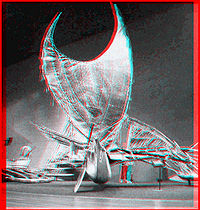Tepukei
A Tepukei (from Te Puke, meaning an ocean-going canoe)is a very old Melanesian boat type, first reported by Spanish explorer Álvaro de Mendaña in 1595, on his visit to the Santa Cruz Islands. However, its possible source may be the Polynesian-speaking inhabitants of Taumako (Duff Islands).
A Tepukei looks like an outrigger canoe with a funny-looking sail, but is in fact a very sophisticated ocean-going sailing ship, belonging to the proa (two hulls of different size) types. Its main differences with other proas are:
- The main hull (vaka) has an almost circular section whose submerged profile remains constant despite heeling, and has a minimum of wet surface when heavily loaded.
- The vaka's top is very close to the flotation line, so it is closed with planks and the accommodations for the crew are on an elevated platform over the akas (the beams connecting the main hull and the smaller, winward hull).
- The typical crab claw sail, one of the most efficient sail types known.
What may be the only surviving original Tepukei is in the Völkerkundemuseum in Berlin, it was brought by Dr. Gerd Koch from the Santa Cruz Islands on 1967.
In recent years however, tepukeis are experiencing a renaissance. The project Vaka Taumako has revived the traditional construction of these boats, and there's a German television documentary about it. David O. Coy is building Tepukeis in San Francisco as well.


